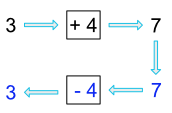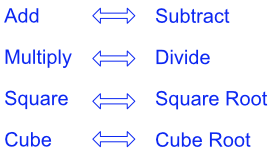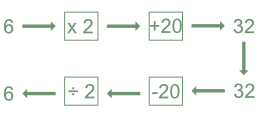Most mathematical operations can be reversed: the operation that undoes the original calculation is known as the inverse operation.
A calculation of 3 + 4 gives a result of 7. The inverse operation starts with the answer (7). The opposite of adding is subtracting, so subtract 4 from 7 to get back to the original number.

Inverse operations work both ways: subtraction is the inverse of addition, and addition is the inverse of subtraction. Some of the inverse operations that need to be known are:

What are the inverse operations for 6 x 2 + 20 = 32?

Answer: Subtract 20; then divide by 2, or (32 - 20) ÷ 2 = 6
Two adults and two children went on a holiday. The total cost of the holiday was £900. The cost for the adults was £290 each. How much was the ticket for each child?
2 x adult + 2 x children = £900
2 x adult = 2 x 290 = £580
£900 - £580 = £320 (the inverse of adding the adults tickets to the cost)
£320 ÷ 2 = £160 (the inverse of multiplying by 2 for the two children.
Answer: £160
See also Inverse Functions and Reciprocals